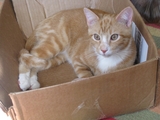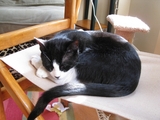When Vernon and Master Lin-chi joined my household I began to think seriously about cat nutrition. I looked at several websites and one book on the subject and began to inform myself.

The first thing you discover: a close reading of the nutritional analysis suffices to establish that commercial catfood is basically crap. Even the high end stuff is wanting.
Then there are the myths. Dry cat food? Worse than the moist. But isn't it good for their teeth? No it isn't. What about kitten, adult and "senior" cat food varieties? Total bullshit. 
Catfood manufacturers cynically exploit cat owners' ignorance by extolling the wholesome goodness of their products containing cranberries and such. They must surely know that cats are obligate carnivores and have no use for cranberries, brown rice, seaweed, etc., no matter how wholesome-sounding. Shamefully, some veterinarians collude with these catfood manufacturers.
So what's a cat owner to do? Well, what have cats done historically, before catfood was invented? Domestic cats lived by hunting and table scraps. Modern feral cats essentially do the same. My urban cats live strictly indoors; they get no birds and few if any mice in their diets. Table scraps won't do it, as I eat little meat. My ziti with carmelized onions and broccoli rabe is of little use to them. It's up to me to simulate something close to their natural diet by providing them with fresh meat and organs purchased for that purpose.
I read about people buying meat grinders and grinding up turkey, chicken and rabbit and feeding it to their cats. This sounded like a cool idea so I got myself a grinder, and promptly broke it on a turkey bone. While procrastinating about calling the manufacturer and inquiring about a repair, I tried paying top-dollar for something called Carnivore Diet, five-pound tubes of ground beef and bone. This seemed like the real deal, and the cats loved it, although there is something unnatural about domestic cats feeding off an animal so many times their size. And at over $15 for the five pounds, it was expensive.
While continuing to procrastinate about the grinder repair, I came across other websites that said grinding is nonsense. When you increase all that surface, you facilitate the growth of taurine-eating bacteria. Do they eat ground mice and birds in the wild? No. The non-grinding school advocates taking things like raw chicken and chopping it into manageable pieces, bones included, and giving to your cats. Ah ha! This approach has the irresistible appeal of Ockham's Razor. Who would have thought that the best way to feed your cat also happens to be the simplest? Get out your meat cleaver and a solid cutting board. Get a chicken or some turkey parts. Hack into pieces. Serve. For dietary balance give them some beef hearts, chicken livers, etc.
Considering cost, this solution compares favorably to the high-end commerical cat food. Perhaps it's more expensive -- if so, it's worth it. People are fond of comparing pets to members of the family. Would you feed garbage to your human loved ones? Would you begrudge the expense of their nourishment? And to be strictly pragmatic about it, the savings on vet bills over your cat's longer, healthier life helps offset the expense. (Of course, you could counter-argue that the cat's extended life means more food consumption, ergo expense. But you'd probably get another cat who would also eat, so it's a wash. Perhaps it boils down to how long you live. Cut your living expenses: smoke cigarettes.)
A further benefit of the raw flesh diet is that it's satisfying for the owner. Nothing is more pleasing than the sound of their little jaws cracking bone, their growling as they warn each other away from their chunk of heart. This is real food. On the rare occasion when I run out of flesh and open a can, I am apalled at its contents: a gray and foul-smelling industrial sludge.


Leave a comment